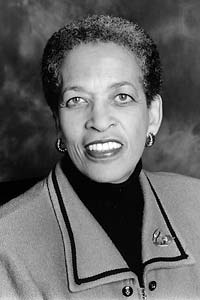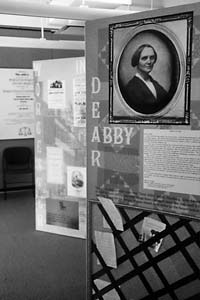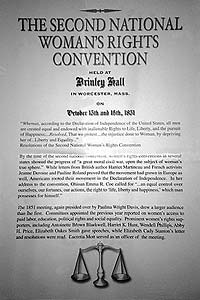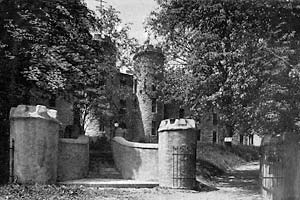WWHP Newsletter Vol. 2, No. 1, Fall 2001
An October Event
 Johnnetta B. Cole will speak on October 30 at 7:00 p.m. in the Hogan Ballroom at the College of the Holy Cross. The title of the lecture is “Difficult Dialogues: Toward a More Inclusive Movement for Race & Gender Equality.” Tickets are $10; free for students.
Johnnetta B. Cole will speak on October 30 at 7:00 p.m. in the Hogan Ballroom at the College of the Holy Cross. The title of the lecture is “Difficult Dialogues: Toward a More Inclusive Movement for Race & Gender Equality.” Tickets are $10; free for students.
There will also be a conversation with students (college and high school) on building alliances for race and gender equality at Worcester State College at 1:00 p.m. in the Blue Room. If interested, please contact WWHP (508-767-1852 or e-mail wwhp@net1plus.com.
Hand Me Downs
YWCA’s annual Daybreak Breakfast. Monday, Oct. 1, 2001, 7:30 a.m. registration; 7:45–9:00 a.m. breakfast and program. Hogan Campus Center, College of the Holy Cross. Special dramatic presentation “Hand Me Downs” written and directed by Jane Dutton. Keynote address “Addressing the Impact of Domestic Violence on Families” by Lundy Bancroft. Tickets $20 pp. Call the Public Relations office at the YWCA, (508) 767-2505, ext. 3019 for information on how to register.
Placing Worcester Along Our Foremothers’ Path
 On my way home from Wisconsin July 31, I visited the special exhibit at the Women’s Rights National Historical Park in Seneca Falls, New York. The ten-panel exhibit, “Reclaiming Our Heritage: Worcester Women’s History, 1850,” created by Dr. Carolyn Howe’s Holy Cross students, continues to educate the public about Worcester’s role in the Women’s Rights Movement.
On my way home from Wisconsin July 31, I visited the special exhibit at the Women’s Rights National Historical Park in Seneca Falls, New York. The ten-panel exhibit, “Reclaiming Our Heritage: Worcester Women’s History, 1850,” created by Dr. Carolyn Howe’s Holy Cross students, continues to educate the public about Worcester’s role in the Women’s Rights Movement.
Now, the story has gone national! The exhibit stands in the center of the special exhibit room surrounded by wall panels about each of the National Woman’s Rights Conventions held before the Civil War. Any visitor who takes the time to read each panel discovers how “Declaration of Sentiments” moved from Seneca Falls in 1848 on toward the post-war Suffrage Movement.
And now, at the close of a hundred years, as the hour-hand of the great clock that marks the centuries points to 1876, we declare our faith in the principles of self government; our full equality with man in natural rights; that woman was made first for her own happiness, with the absolute right to herself-to all the opportunities and advantages life affords for her complete development; and we deny that dogma of the centuries, incorporated in the codes of all nations-that woman was made for man-her best interest…to be sacrificed to his will.
We ask of our rulers, at this hour, no special privileges, no special legislation. We ask justice, we ask equality we ask that all the civil and political rights that belong to citizens of the United States be guaranteed to us and our daughters forever.
Conclusion of Susan B. Anthony’s “Declaration of Rights,”
Philadelphia on July 4, 1876
As the nation celebrated the Declaration of Independence in the new century, it was fitting to open such an exhibit on July 4. If you have not yet had a chance to spend time exploring this wonderful display, I urge you to explore the entire Women’s Rights Museum (about a six-hour drive from Worcester). It will close on September 29 to return for our celebration of the Second National Woman’s Rights Convention in October.
Calling All Educators
In July, the state Board of Education agreed to stop testing students about world history on the Massachusetts Comprehensive Assessment System (MCAS) exam and instead focus more on U.S. history. THE TIME IS NOW to educate students of all ages about the role women have played in shaping Worcester County’s and America’s history.
The Education Committee is looking for creative, energetic members who are eager to move WWHP’s resources into action throughout Worcester County. If you are interested in moving herstory forward and learning it at the same time, contact Jessie Rodrique (508-767-1852)or either Education Committee Co-chair, Linda Miller (canoter@juno.com) or Karen Moran (kmoran@massed.net). You will be notified of the next meeting.
Making the World Better
The Massachusetts Foundation for the Humanities and the Tsongas Industrial History Center at UMass/ Lowell have just reprinted the curriculum packet, “Making the World Better: The Struggle for Equality in 19th-Century America,” developed as part of the State House Women’s Leadership Project.
The centerpiece of the project is a new work of public art, permanently installed in the State House in October 1999, that honors six women who made significant contributions to public life in Massachusetts. Designed for middle and high school students, the curriculum focuses on two of these women: abolitionist and suffrage leader Lucy Stone (1818–1893) and African-American abolitionist Sarah Parker Remond (1824–1894). It includes a folder with biographical information and a time line, a selection of edited primary source documents, and a Teacher’s Guide with learning activities and resources.
The Making the World Better curriculum packet is available, free of charge, to classroom teachers and home-school parents. To order your copy, call (617) 923-1678 or e-mail MTWB@mfh.org. An electronic version is posted on the Massachusetts Foundation for the Humanities’ website, www.mfh.org/specialprojects/shwlp/site/curriculum.
Letter to the Editor
A reader from Cambridge, Massachusetts recently sent in a postcard saying how much she loved the newsletter. She also wanted to inquire as to the the origin or meaning of the term “Oread.” The last issue of the newsletter featured a story about this Worcester institution that is considered the first four-year college to offer instruction exclusively for women. This issue features one notable instructor at the Oread, Helen Mary Knowlton (see page 4).
Founder Eli Thayer called the new school the Oread Collegiate Institute, and named the hill on which it stands Mt. Oread. The name was suggested by Vergil’s lines on the mountain nymphs who followed Diana, the Goddess of the Hunt. The building was called by the pupils “Oread Castle.” So, reader, we hope this answers your question. Thank you for writing in.
Second National Woman's Rights Convention
Brinley Hall in Worcester, Mass. October 15th and 16th, 1851
By the time of the second national convention, women’s rights conventions in several states showed the progress of “a great moral civil war, upon the subject of woman's true sphere." While letters from British author Harriet Martineau and French activists Jeanne Deroine and Pauline Roland proved that the movement had grown in Europe as well, Americans rooted their movement in the Declaration of Independence. In her address to the convention, Ohioan Emma R. Coe called for “. . . an equal control over ourselves, our fortunes, our actions, the right to ‘life, liberty and happiness,’ which man possesses for himself."
The 1851 meeting, again presided over by Paulina Wright Davis, drew a larger audience than the first. Committees appointed the previous year reported on women’s access to paid labor, education, political rights and social equality. Prominent women’s rights supporters, including Antoinette Brown Blackwell, Harriet K. Hunt, Wendell Phillips, Abby H. Price, and Elizabeth Oakes Smith gave speeches, while Elizabeth Cady Stanton’s letter and resolutions were read. Lucretia Mott served as an officer of the meeting.
Quoted from Vivien Rose, Jamie Wolfe and Anne Derousie, Curators of “Declarations of Independence” exhibit.
The Call—1851
 The sign on the left is featured one of the ten-panels in the exhibit, “Declarations of Independence,” now on display at the Women’s Rights National Historical Park in Seneca Falls, New York. The sign displays the call to the Second National Woman's Rights Convention. The text that appears on the sign is reproduced below.
The sign on the left is featured one of the ten-panels in the exhibit, “Declarations of Independence,” now on display at the Women’s Rights National Historical Park in Seneca Falls, New York. The sign displays the call to the Second National Woman's Rights Convention. The text that appears on the sign is reproduced below.
In accordance with a vote of the Woman’s Rights Convention held in Worcester, Mass., the 23d and 24th of October last, viz: “to meet in convention annually, to consider the Rights, Duties and Relations of Woman,” a Convention will be held in Worcester the 15th and 16th of October next.— We invite all, both men and women, to meet at the appointed time and place, for the free and full discussion of this great question.
The cause itself, affecting as it does the destiny of the race, takes the front rank in those Reform Movements, which the progressive spirit of the age has called into being, and invites to its aid all who see and feel the wrongs which grow out of the false position of Woman, and who, having “No dread of what is called for by the instinct of mankind,” dare give to such a movement the sanction of their presence, and to embody in word and deed, the thought and feeling which they must have, who see that Woman Socially, Civilly, Religiously and Educationally sustains an unnatural and unworthy position.
The work contemplated is no child’s play. It wars directly with the thought so deeply rooted and so hoary, that Woman is only an appendage, and not an integral part in the fabric of human society. It is in full conflict with the world's teachers, its preachers, its lawgivers, it poets and its painters. It stands opposed to those soul-blighting usages of society, which have consigned Woman to an aimless and objectiveless existence, and have baptized a life so unworthy, as peculiarly fitting and graceful for Woman.
Such are some of the circumstances. Come then to the Convention, prepared, as thought meets thought, to seize and use each ray of light in dispelling the darkness which is spread every where relative to Woman's Rights, and the Duties which grow out of those Rights.
N.B.— Papers friendly to the movement are requested to copy the above.
In behalf of the Committee,
Lucy Stone
Paulina W. Davis
Wm. H. Channing
History from the Oread: Helen Mary Knowlton, Artist, Teacher, Biographer
 Helen Mary Knowlton (1832–1918) taught guitar at the Oread from 1865–69 while pursuing her art career as a painter and teacher in Boston. Helen was a Worcester native and educated in the public and private schools here.
Helen Mary Knowlton (1832–1918) taught guitar at the Oread from 1865–69 while pursuing her art career as a painter and teacher in Boston. Helen was a Worcester native and educated in the public and private schools here.
Helen’s father started the newspaper, the Worcester Palladium in 1834 and published it until his death in 1871. Helen and her two sisters ran the paper for a number of years after his death.

Helen Mary Knowlton, Portrait of William Morris Hunt. Oil on canvas. Worcester Art Museum, Worcester, Massachusetts, Gift of Helen M. Knowlton. 1896.1.
Helen opened her own studio in Boston in 1867 and in 1868, she asked William Morris Hunt to offer classes to a group of forty women. Knowlton became a devoted pupil of Hunt’s and eventually took over his classes, teaching his experimental approach to art. She became his principle biographer, publishing Talks on Art (1875), Hints for Pupils in Drawing and Painting (1879) and The Art-Life of William Morris Hunt (1899). After his death in 1879, Knowlton helped to arrange a retrospective of his work for the MFA in Boston. In 1880, Knowlton shifted her focus from landscape to portraiture—her first portrait was of Hunt, a work that was exhibited at the MFA and eventually made its way to the Worcester Art Museum in 1896. It was the first acquisition of the WAM, two years before it opened in 1898.
Helen wrote art criticism for the Boston Post and continued to teach art classes until her early seventies. Her work was exhibited at the National Academy in New York and the Pennsylvania Academy in Philadelphia. Helen Mary Knowlton, along with forty-four other women artists, is currently featured in an exhibit at the MFA entitled “A Studio of Her Own: Women Artists in Boston 1870–1940” Her portrait of Hunt, on loan from the Worcester Art Museum, is featured in the exhibit.
Helen died in Needham on May 5th, 1918 at the age of eighty-five and is buried in Rural Cemetery in Worcester.
Find Out More
To find out more about Helen Mary Knowlton, visit Ask Art, and the Museum of Fine Arts exhibit, “A Studio of Her Own: Women Artists in Boston 1870–1940,”.
References
Notable American Women 1607–1950. Edward P. James, et. al. Harvard University Press, Cambridge, MA, 1971.
History of the Oread Collegiate Institute, Worcester, MA 1849–1881. Martha Burt Wright, editor. New Haven, Connecticut, 1905. From the collection of Worcester Historical Museum, Worcester, MA.
Worcester Exhibit Goes to Seneca Falls
The traveling exhibit, “Reclaiming Our Heritage: Worcester Women’s History, 1850” has spent the summer in Seneca Falls, New York at the Women’s Rights National Historical Park. The exhibit, created by Carolyn Howe and students from College of the Holy Cross, tells the story of the first National Woman’s Rights Convention, the abolitionist and temperance movements that helped give rise to the women’s rights movement, and life in Worcester in 1850.
Jessie Rodrique and Carolyn Howe went to Seneca Falls for the July 4th opening of a joint exhibit between the WWHP and the Women’s Rights National Historic Park.
The Women’s Rights National Park exhibit “Declarations of Independence” tells the story of the national women’s rights conventions of the 1850s. In the special exhibitions room at the Women’s Rights Park, the Worcester exhibit dominates the center of the room. On the surrounding walls, large panels tell the story of the other national conventions, including the second national convention which was held in Worcester.
The wall exhibits were researched and written by Vivien E. Rose and Anne M. Derousie and Jamie Wolfe of the Women’s Rights National Historical Park.
The Women’s Rights National Historical Park and the Worcester Women’s History Project hope that this joint exhibit on the conventions of the 1850s can travel to other sites around the country, perhaps to the cities where other conventions were held, inspiring others to research and tell the story of the conventions that were held in their cities. The exhibit will be at Seneca Falls until September 29, 2001.
From The President
This will be my last message to you as President of the Worcester Women’s History Project. At the Annual Membership Meeting and Dinner on September 9, 2001, the WWHP will elect a new Executive Committee and new members of the Steering Committee. I hope you will come to the membership meeting and show support for the new officers and Steering Committee who will lead us into the post-Women 2000 phase of our existence.
It has been a pleasure to serve the WWHP as President for the past two years (and as Clerk the two years before that). I enjoyed helping to develop the program for Women 2000 and do what I could to make it a resounding success. For the past nine months, I have enjoyed working with the Heritage Trail Committee, the Education Committee, and the October Event committee to help move the WWHP’s vision forward. I will continue to serve on the Steering Committee for one more year.
We have continued to move forward on the Heritage Trail and hope to have a preliminary booklet with a trail guide available by March. The Education Committee will soon produce an educational brochure that will accompany the traveling ten-panel exhibit on the first National Woman’s Rights Convention and Worcester life in 1850. We are also hoping to produce a second copy of the exhibit that will be lighter and easier to move from place to place. We are looking into some exciting possibilities for getting more national exposure for Abby Kelley Foster and the important work she did for abolition and for women’s rights. Finally, we are collaborating with other organizations to host Dr. Johnnetta B. Cole at our October event. Dr. Cole will be speaking on Tuesday, October 30, at 7:00 p.m. at the Hogan Ballroom at College of the Holy Cross. Her topic is “Difficult Dialogues: Toward More Inclusive Movements for Race and Gender Equality.”
To carry out the important work of the WWHP, we unfortunately need money. If you haven’t already done so, please send in your $25 membership dues and be as generous as you can with additional support for our programs.

